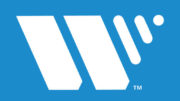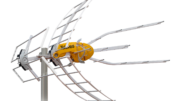Take a look at this antenna… There are a lot of parts there. This antenna is typical of a “hybrid yagi log periodic” type antenna. The left side uses small metal bars and larger, angled panels to focus UHF signals on a specific point. The right side uses an array of metal bars increasing in size. Every bar pulls in a specific set of frequencies. Each one of those horizontal bars is called an “element” and when you put them all together, you get a powerful antenna that can get 80 mile reception without the need for an amplifier.
Does the number of elements really matter?
It certainly does. The more elements you have, the more each element can be fine-tuned. Every element is actually its own little antenna in its own right, and it an be fine-tuned to receive a range of frequencies or just one single frequency. The bigger the range of frequencies that an antenna’s tuned for, the less powerful it is. That means that if you have a single-element dipole (like a rabbit ears antenna) it’s going to need a lot of adjustment to pick up all the frequencies you want. On the other hand, an antenna like this HD8200XL with 69 elements can have each one precisely tuned to a single channel, and that means max power.
When it comes to the number of directors (the small metal bars), the more the merrier. As you add them, you focus more signal on one point. However, at the same time the antenna’s ability to pick up signals from the sides (instead of aimed straight on) goes down.
As for the log periodic elements, the ones where every one is larger than the last, ideally you want one for every channel in the VHF spectrum. So it’s true, any more than 12 would be a bit of a waste. However, some very large VHF antennas use more than one element per channel just to improve reception. This is less common today.
Other factors in play
The number of elements isn’t the only factor, though. If you only need UHF, as much of the country does, you’re not even using half those elements, and UHF frequencies respond much better to a single-element antenna than VHF does. It’s also important that the antenna is mounted in the right place, without obstructions, and that an amplifier is used when needed.
The bottom line is… if you need to pick up a lot of VHF stations from far away, you’ll want an antenna with a lot of elements. Otherwise, you may be better off with something simpler.
If you’re looking for the right antenna, you’ve come to the right place. SolidSignal.com has all the best brands at the best prices. Shop our great selection now. Not sure what you need? Call the experts! We’re here for you during East Coast business hours. The number is 888-233-7563. If it’s after hours, no problem! Fill out the form below, and we’ll get back to you, usually within one business day.





